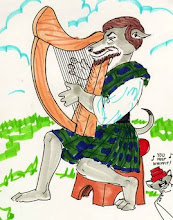BRIEF HISTORY OF THE BREED
The Phoenicians brought sight hounds into Cornwall as early as 1,000 B.C. The Phoenicians were desperate for tin and copper, and the Cornish were equally anxious for, amongst other things, fast dogs that were able to catch the rabbits and other small game which were a major source of food. Pottery from this period, now in the British Museum, show two types of dogs - one a small fox-like animal and the other looking a little larger than our own Whippets, very lightly built with long, curled, very fine tails. Some had erect ears and others the rose type (perhaps this is where our prick ear problems came from). They appeared very arched in the back with flat ribs hardly reaching their elbows.
In the Middle Ages the larger greyhounds were always owned by the nobility, and were used for hunting such game as the royal deer. Poorer people, often at considerable risk, acquired the smaller hounds which were ideal for poaching. The best dog for poachers was the fast, silent one, who didn’t advertise his presence by barking, and of a dark colour, so that he was hard for the gamekeepers to see. Perhaps this is why, to this day, the blues and blacks of the Whippet and greyhound breeds tend to be very fast. One only has to look at the racetrack to see the number of blues and blacks there in comparison to the number in the show ring.
They also needed to hunt in close cooperation with their master, and this trait is still noticeable in the modern Whippet. Whereas most Hounds hunt in a pack, with man keeping up as best he can on foot or on horseback, the Whippet works closely with his master; he will chase his game but will return, unlike many hounds.
His small size also made him the ideal lady’s pet or house dog, long before the more exotic toy breeds were introduced into England, and, as John Taylor, a poet, wrote in 1630: “In shapes and forms of dogges; of which there are but two sorts that are useful for man’s profit, which two are the mastiff and the little whippet, or housedogge; all the rest are for pleasure or recreation.”
Probably also because of his small size and the resulting small appetite, he became the poor man’s racing dog. It is quite strange however since the early Cornish tin miners’ days, other miners seem to have adopted whippet racing as their sport. This was true even in the goldfields of Western Australia where whippet racing was very popular in the early days.
The first mention of the Whippet as a show dog was on July 28, 1876, at the annual exhibition of "Sporting and Other Dogs” in Woodside Park, Darlington, in the North of England, featuring classes including Whippets. It took 14 more years for the Whippet to become recognised by the Kennel Club, Herbert Vickers requesting official recognition for the Whippet breed on April 16, 1890.
"Brief History of the Breed"
Extended Breed Standard of THE WHIPPET
Australian National Kennel Council, 2007
http://www.ankc.org.au/_uploads/docs/233437Whippet_BSE.pdf
Monday, September 26, 2011
Subscribe to:
Post Comments (Atom)




No comments:
Post a Comment